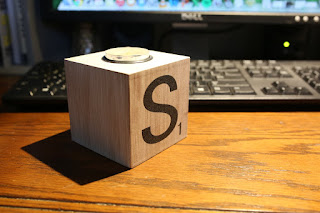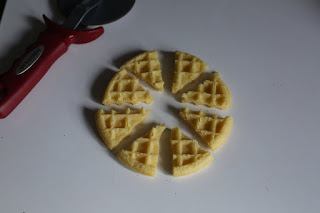So lets start with math, in specific, fractions!
The only thing we need to do is to learn how to multiply and divide a fraction by 2.
Here's my waffle:
I am going to share it so I cut it into two peices:
I have two halves of my waffle and I want to divide them by 2. If I did I would end up with 4 pieces or fourth pieces (1/4) of my waffle (1 half of my half) . This is great because now I can share it with 4 people!
1/2 divided by 2 = 1/4
Since dividing fractions is just like multiplying to make it a little simpler. If I need a half of my 1/4 I would end up with 1/8 of a pieces.
Quick cheat: Multiply denominator by two
If I were to continue it would go as follows:
1/16, 32, 64, 128 ,256.
Now the opposite: If I wanted to increase my pieces by 2 then I would multiply.
So if I had an 1/8 x 2 = 2/8 or 1/4
If I then decided to do it again my 1/4 x 2= 2/4 or 1/2 (right back to the beginning)
Quick cheat: divide the dominator by two.
The same would happen if we were multiplying and dividing by 3's. Heres a quick example but all we are concerned about to day is 2's !
What if I were to decrease by 3 then: 1/2 / 3 = 1/6
What if I were to increase by 3 then: 1/6 x 3 = 1/2
THATS IT WITH THE MATH LETS MOVE ON TO PHOTOGRAPHY!!!
If you have ever been around photographers or watched a you tube video they always talk about adjusting by "stops" or how lenses offers you "stops" (image stabilization and aperture) . When I first was interested in photography I would talk to a guy, and he would be bombarded with his "stops" talk. I understood .01% of what he was talking about most of the time we talked . However, I still listened because I knew one day I would understand.
"STOPS" EXPLAINED(only full stops):
Just understand this, if you go up or down by 2 you are moving 1 Full Stop. That's it! Up and down changes in respect to what we are talking about but I'll explain in future post!
If you must know the technical side of things CLICK HERE!!
Here is a list of how full stops relates to different camera settings(aperture, shutter speed, and ISO)
Aperture (Lens)
1.4 - 2.8 - 5.6 - 11- 221 - 2 - 4- 8- 16
Normally seen: 1 - 1.4 - 2 - 2.8 - 4 - 5.6 - 8 - 11 - 16 - 22
Shutter speed (Camera Shutter)
1/2 - 1/4 - 1/8 - 1/16 - 1/32 - 1/64 (<---look familiar)ISO (Sensor/Film)
3200 - 1600 - 800 - 400 - 200- 100 - 50The numbers listed above are from brightest to darkest setting. We will go into this later. But enough with the talking lets test it out.
Aperture
We will just be working on Aperture. Aperture is determined by your lens. Normal kit lenses come with an max aperture setting of f5.6 or lower. Lower? In the camera world the bigger aperture number is the lower and slower the lens is. They are usually not good for low light settings. If you look at the professional series for your camera lenses, they start at f/4 and go to f/1.2. The are also called "faster " because they allow more light into the camera which uses a faster shutter speed. These lenses are great in low light situations, but have two draw backs. Do you know what they are? Below is the difference between f/2.8 and f/1.8. |
| Picture can be found here |
TERMS TO LEARN (Aperture)
-Stop down: from high to low aperture or large(f2.8) to small (f5.6)-Stop up: Just the opposite
PRACTICE FOR THE WEEK
For the next week or so play around with this setting, and tell me what you find out!The Setup:
1) Put your camera in AV mode aka aperture priority! (LEAVE IT THERE FOR THE WEEK)
2) Set your ISO to AUTO ( for now)
3) Start shooting. Go outside, inside, shoot at night, or anything else that tickles your fancy.
4) Be sure to say out loud what you are doing. if you are are f5.6 and go to f/11 say out loud, "I'm going up a full stop of light"
5) Repeat this to yourself and write it down so you under stand whats happening
Questions to ask yourself?
What is happening to my background as I change stops?
What is happening to the foreground?
How does you camera sound when you take a shot? Slow or Fast?
How has my ISO or Shutter speed changed when I take each shot?
Are any pictures blurry or grainy?
Here are all my practice shots below:

f/1.4

f/2.8

f/5.6

f/11











